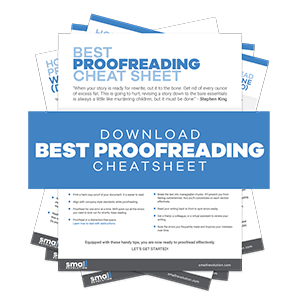Imagine chancing upon an article with a killer headline. It is succinct and uses effective, persuasive language.
You click on it and begin to read.
Right in the introduction, the copy is riddled with punctuation mistakes, awkward spacing, misspellings, and run-on sentences.
Chances are, you wouldn’t continue reading…
So why would you repeat a similar mistake on your blog?
Proofreading errors turn off readers and reduce engagement on your blog. Yet, blog engagement is crucial for improved SEO ranking and building visibility.
Blog posts that have been accurately proofread are easy on the eye and the mind. They read well, are easy to follow, and woo the reader into taking action.
Many bloggers fall short of publishing error-free content due to time constraints or poor skills. You shouldn’t face similar constraints when you can leverage ChatGPT’s accurate proofreading capabilities.
ChatGPT is an AI service that can proofread text for grammatical and punctuation errors, improve word choices, and give suggestions for tone and voice to enhance readability. Its capabilities will enable you to achieve your proofreading goals.
In this article, we show you how to proofread accurately using ChatGPT to improve reader satisfaction and maximize blog engagement.
Understanding Blog Engagement: Why It Matters

Remember the last time you read an article and, halfway through, you scrolled to the bottom, hit the Like button, or shared the link?
Or perhaps you completed reading the article and left it at that?
Any form of interaction or activity on a blog post is termed as engagement.
Passive forms of engagement occur when a reader reads an article and does not take further action.
Active engagement happens when a reader interacts further with a post by liking it, commenting, or sharing it on social media.
Building engagement is critical for every blog because it fosters a connection between you and your readers. A focus on building blog engagement results in a devoted community of readers for your blog.
This translates to:
- Increased traffic as more readers come back for more content.
- Improved SEO ranking: Google takes user engagement into account when appropriating ranks to content pieces.
- Potential for building blog visibility as loyal readers share your content through various social media channels.
If your blog supports an eCommerce store, engagement with your online marketing increases the likelihood of converting devoted readers into buyers.
The Hubspot Blog is an example of a successful blog having more than 400,000 subscribers and more than 4.5 million monthly visitors, according to SimilarWeb. The site experiences a bounce rate of 80.18 percent, and visitors view an average of 1.55 pages per visit.
Look at their engagement metrics below.
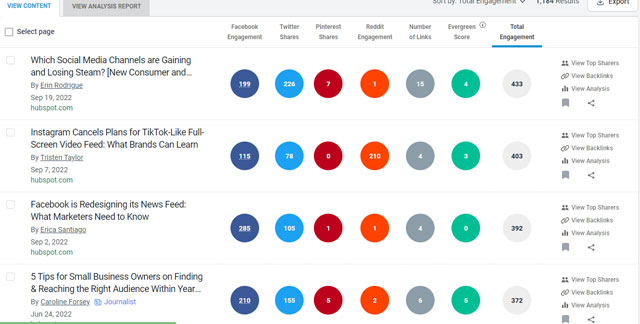
In the screenshot above, we can see the engagement metrics of some top posts. Taking the first post, ‘Which Social Media Channels are Gaining and Losing Steam?’, the engagement metrics are:
- Total Engagement: 433
- Facebook Engagement: 198
- Twitter Shares: 226
- Reddit Engagement: 1
- Number of Links: 15
Clicking in a given circle can show the types of engagement. E.g., likes, shares, and comments on Facebook.
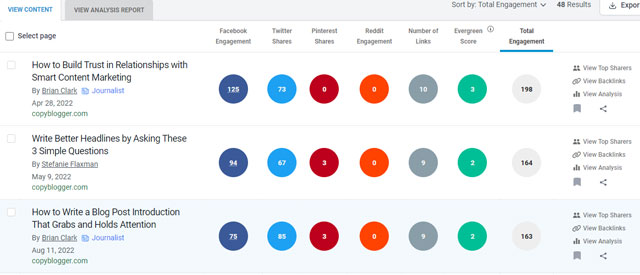
Copyblogger is another example of a successful blog, having had 312.8K visitors in March 2023, according to SimilarWeb. Site visitors view an average of 1.7 pages per visit, with a bounce rate of 71.56 percent.
You can also see the total engagement on the top three performing posts on the blog.
You must accurately proofread all your content to build engagement like these successful blogs. Proofreading all your content translates to publishing only error-free, quality content, which boosts reader satisfaction and increases engagement.
Establish Credibility Through Accurate Proofreading

A content piece that’s proofread well speaks to the credibility of its author and their writing skills.
Proofreading accurately shows that you take pride in your work and exercise great care in how you present it.
Readers will want to associate with you and your content creation work because they want to be treated to neat-looking content.
Quality, proofread content flows effortlessly as you read, enhancing the comprehension of information.
Other benefits of proofreading content include:
- Increased shareability: Readers will likely share clear and visually appealing blog posts.
- Increased reader satisfaction: Readers feel appreciated that the writer considered them and took great care in presenting the information.
- Maintained blog credibility: Posts that are consistently well-organized and error-free solidify the authority of a blogger.
Common Blog Errors That Hurt Engagement
Some common blog errors include grammatical issues like:
- Tense inconsistency
- Subject-verb disagreement
- Improper use of articles, adjectives, or adverbs
- Unclear expression of thoughts
In some cases, readers may not notice errors.
However, errors such as missing words or improper use of adjectives can change the entire meaning of a sentence.
In both cases, blog errors interfere with the achievement of your writing goals.
Blog errors leave a reader confused or frustrated with your content. They are unlikely to consume your content at all after that.
In the ‘best-case’ scenario, they will engage passively with your article, which hurts your visibility, because they refrain from sharing the content and bringing in more readers.
Improve Blog Quality With ChatGPT’s Proofreading Features
ChatGPT has an AI-powered proofreading feature that handles all those pesky grammar issues.
Given clear prompts, it can scan a piece of text and pinpoint grammar, spelling, punctuation, and tense use errors within less time than you would take.
ChatGPT also improves accuracy by catching and revising freelance writing errors that would ordinarily slip by you.
In summary, accurate proofreading enhances blog quality and readership by:
- Presenting error-free content that improves readability
- Building and maintaining trust with your readers
- Boosting social media sharing
- Building your credibility as a blogger
ChatGPT’s AI-powered proofreading feature can be essential in eliminating errors in copy editing jobs.
How ChatGPT Works
ChatGPT is a conversational chatbot by OpenAI that relies on the prompts you send to output relevant information to the query.
It uses natural language processing to understand prompts and provide original responses.
Some of its features include:
- An ability to understand queries and output accurate answers
- The ability to remember conversations
- The potential to contextualize answers
It can aid writing improvement by:
- Generating ideas for your blog
- Assisting with writing and editing
- Fixing grammar and punctuation mistakes
You can improve the quality of your copy editing work by using ChatGPT to proofread.
How to Use ChatGPT for Proofreading
Here is how you can use ChatGPT’s editing software to proofread:
- Log into your ChatGPT account.
- Input a specific prompt e.g. Proofread the following text for grammatical and punctuation errors. Tell me any changes you make and why. Then input the text.
- Check the output ChatGPT provides.
- Edit your document.
Wondering what proofreading errors ChatGPT can find in your online writing work? ChatGPT says:
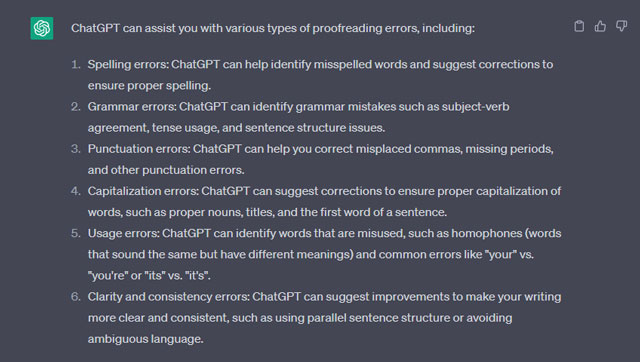
Let’s ask ChatGPT to correct this short paragraph on the benefits of traveling:
“Travelling is an wondrful exprence.You can see amazing cites,test delicious food.and meet new ppl. It teaches you that there is no rite way of done things so you Become more open-minded and tolrant of others.”
See the prompt and output from ChatGPT below.
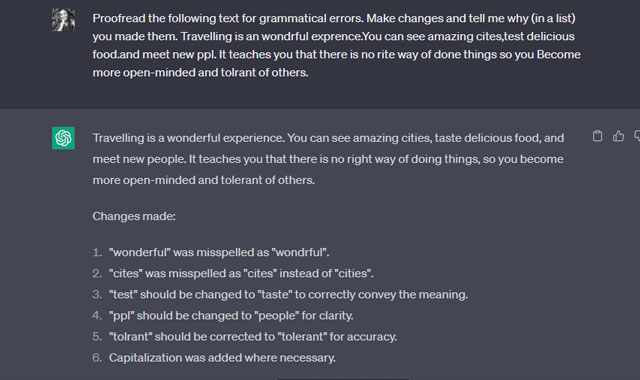
Can you see how ChatGPT revised all errors? Misspellings, wrong word choices, inconsistent spacing, inappropriate capitalization, and punctuation choices.
However, it did not list them all.
You should always review the changes from ChatGPT’s proofreading services and check that they maintain the original meaning.
For instance, in the second sentence, I meant to write, ‘You can see amazing sites, taste delicious food, and meet new people.’ ChatGPT’s output changed cites to cities instead. Luckily, it’s not a great departure, so the sentence still makes sense.
You can take writing advice from ChatGPT because its algorithms have features that improve accuracy. They are:
- Attention mechanisms: ChatGPT can focus on the most relevant parts of your text input.
- Dropout regularization: It is designed to focus on general patterns and apply them to new data.
- The ability to recognize patterns and relationships between words and phrases: ChatGPT refines its understanding of language and improves output accuracy as you input more information.
- The ability to learn and adapt to new information over time.
Using ChatGPT for Future Success
We have established the essence of using ChatGPT for accurate proofreading. You can use ChatGPT to produce error-free writing and improve engagement on your blog by using these blogging tips:
1: Use ChatGPT for Every Blog Post
You’ve found a tool that works. Every. SSingle. TTime.
Leverage its power by using it for every blog post that you work on.
The short ones. The long ones. The ‘super fun, no big deal’ ones.
ChatGPT’s proofreading capabilities can improve your posts’ article quality and readability, and increase blog engagement.
If you churn out a large number of posts to meet content creation goals, ChatGPT’s proofreading services will also improve your writing productivity.
Publish only quality, error-free blog posts, and build credibility as a blogger presenting visually appealing, coherent content.
Remember the golden rule of always reviewing the output that ChatGPT returns.
2: Optimize for SEO
You can use ChatGPT to improve your SEO copywriting skills and rank well on Google.
SEO is key to increasing the visibility of your posts and improving traffic.
You can achieve this by using the following prompts:
- Provide keywords related to {insert specific topic}.
- Can you list long-tail keywords that {insert target audience description} might use to search for {insert topic}.
You can also ask ChatGPT to write SEO meta descriptions, as seen below.
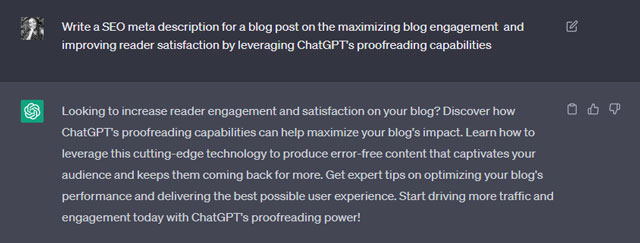
Go further by asking ChatGPT to modify the meta description to improve optimization.

The second meta description follows the best-practice rule to keep meta descriptions under 160 characters to avoid getting trimmed by Google.
It is concise yet descriptive enough to persuade readers that the article has the content they want.
Therefore, it can help increase clicks and conversions.
3: Use Specific and Clear Prompts
Know how anyone pursuing a career in eCommerce must understand eCommerce specialized language?
You must also understand your audience and mirror their language and tone.
Bloggers can eliminate writing challenges, like the wrong tone of voice in their writing, using ChatGPT.
You can achieve this by using clear prompts such as:
- Re-write this using a conversational tone.
- Revise the following text using formal language.
- Modify the tone of this text to make it more persuasive.
- Make the tone of the following text academic.
You can proofread text using varied proficiency levels based on the needs of your blog.
To do this, you can ask ChatGPT to:
- Proofread at a basic level: Proofread the following text for spelling or grammatical errors.
- Proofread at an intermediate level: Proofread this text for advanced grammar mistakes and suggest corrections.
- Proofread at an advanced level: Proofread this text for advanced grammar mistakes and suggest more advanced vocabulary or phrasing.
Examples of advanced grammar mistakes can include:
- Relative pronoun misuse: Using ‘who’ instead of ‘whom’ or ‘which’ instead of ‘that.’
- Incorrect parallelisms, e.g., Vicky had to wash, do the ironing, and shopping before her mom returned home.
- Dangling modifiers, e.g., having finished my homework, the TV was turned on. Dangling modifiers cause a lack of clarity in sentences.
4: Have a Second Pair of Eyes
ChatGPT is an excellent tool for proofreading. However, having another person review your work cannot hurt, especially if you are a proofreading beginner.
Ask another blogger or a friend to examine your work before publishing. They might catch proofreading errors that ChatGPT missed and provide writing tips to improve the quality of your post. They might also suggest better phrasing or word choices in some areas.
This is especially so because they are not as ‘close’ to your work as you are. Plus, they are human and can suggest revisions based on what they enjoy reading.
ChatGPT can give human-like responses but cannot replace a human being’s perspective.
5: Experiment With Different Tools and Methods
Bloggers can leverage numerous writing tools to improve the quality of their blog posts aside from ChatGPT.
Survey tools such as Qeryz can help you increase engagement by discovering your readers’ main interests. Then you can provide unique content on those topics.
You can also find writing motivation on BuzzSumo. Use it to analyze popular topics and land ideas that will create a buzz on your blog and then monitor mentions.
Other tools, such as Disqus, make commenting on posts easier for readers, while Hootsuite facilitates social media sharing.
Accurate proofreading is an essential skill that all writers in the writing community should develop by leveraging ChatGPT and other writing resources.
It ensures that blog posts are clear, ideas flow, and they contain smooth transitions. Readers enjoy reading such quality content, and feel appreciated by virtue of the care a writer takes in their work.
If you can achieve this every time, readers will stick with you for the long haul. Not just that, but they will happily share your content with others and increase traffic to your site.
With ChatGPT’s proofreading capabilities, you can publish posts that are accurately proofread and improve blog engagement and reader satisfaction.
ChatGPT can proofread at different proficiency levels to meet your blogging goals. It helps boost blog engagement by eliminating grammar and punctuation errors, adjusting the tone, and optimizing for SEO.
It does so in considerably less time, so you can write more quality work and increase your writing income. Or begin a proofreading side hustle.
Try ChatGPT and eliminate all proofreading errors today.
Use ChatGPT’s Proofreading Power to Boost Blog Engagement
Bloggers can enjoy increased blog engagement and build a loyal community of readers by leveraging ChatGPT’s proofreading capabilities.
They can increase blog engagement by using ChatGPT to:
- Improve their writing techniques and adjust their writing tone
- Improve clarity by removing wordiness
- Optimize for SEO
Polishing your posts using ChatGPT increases dwell time on your posts and encourages readers to share through social media platforms.
There’s a cost to achieving high blog engagement and reader satisfaction: quality, coherent, error-free content.
Begin using ChatGPT for accurate proofreading and maximize your blog engagement today.


